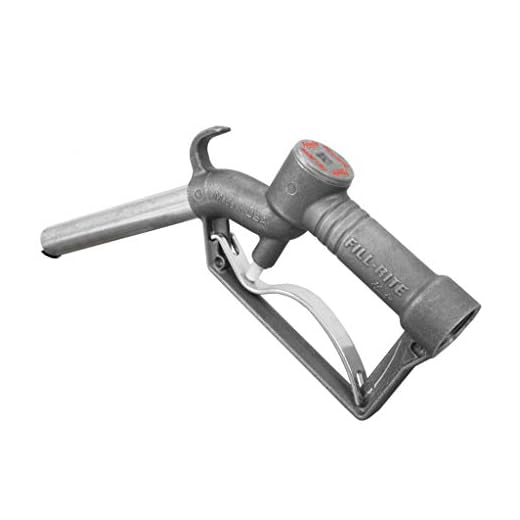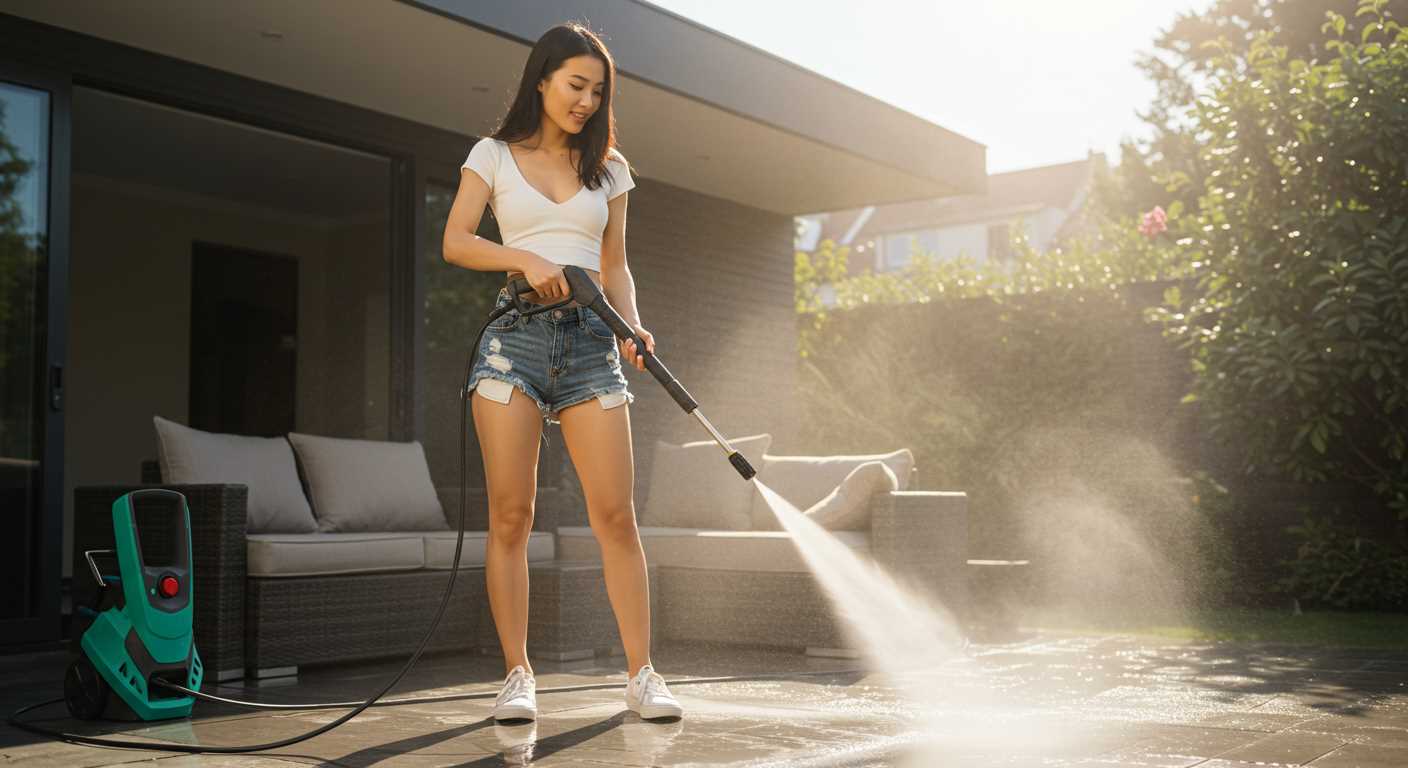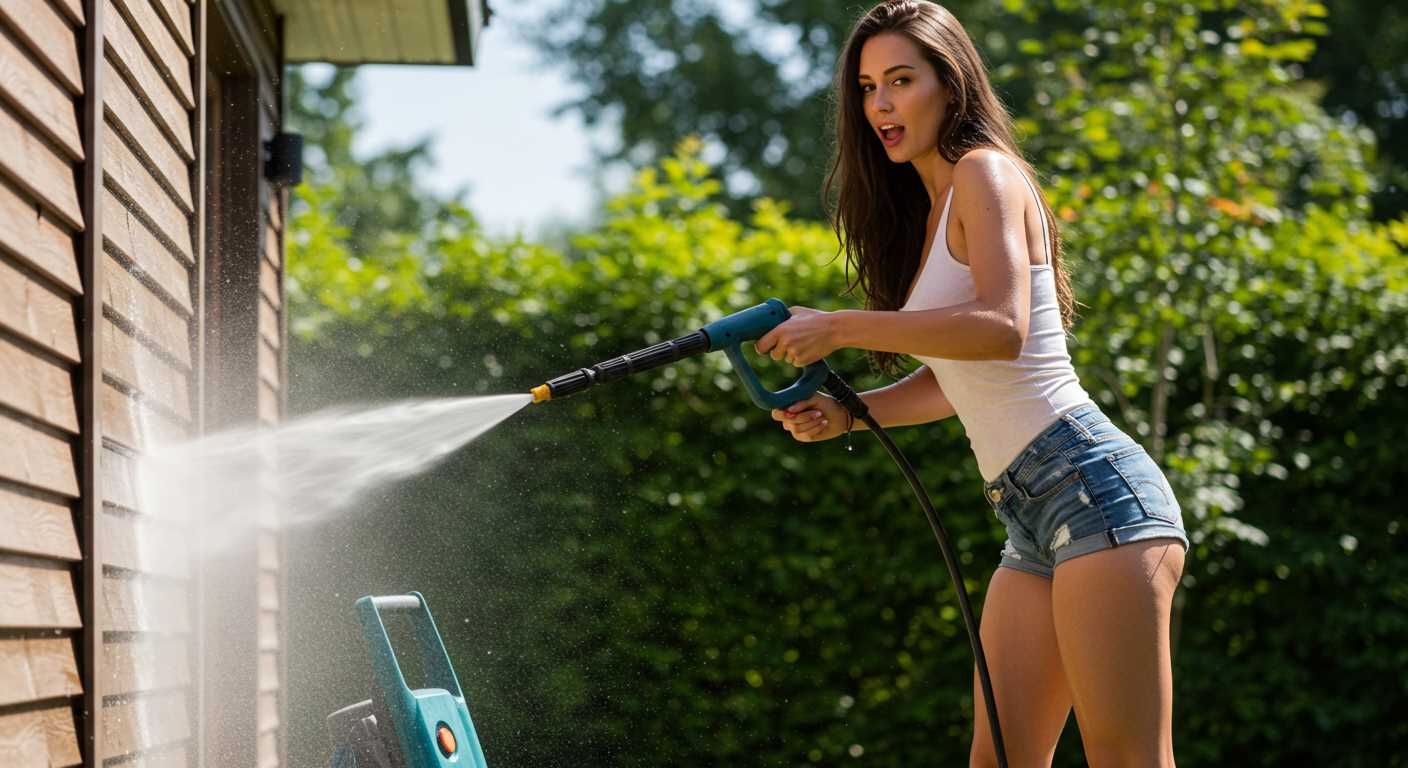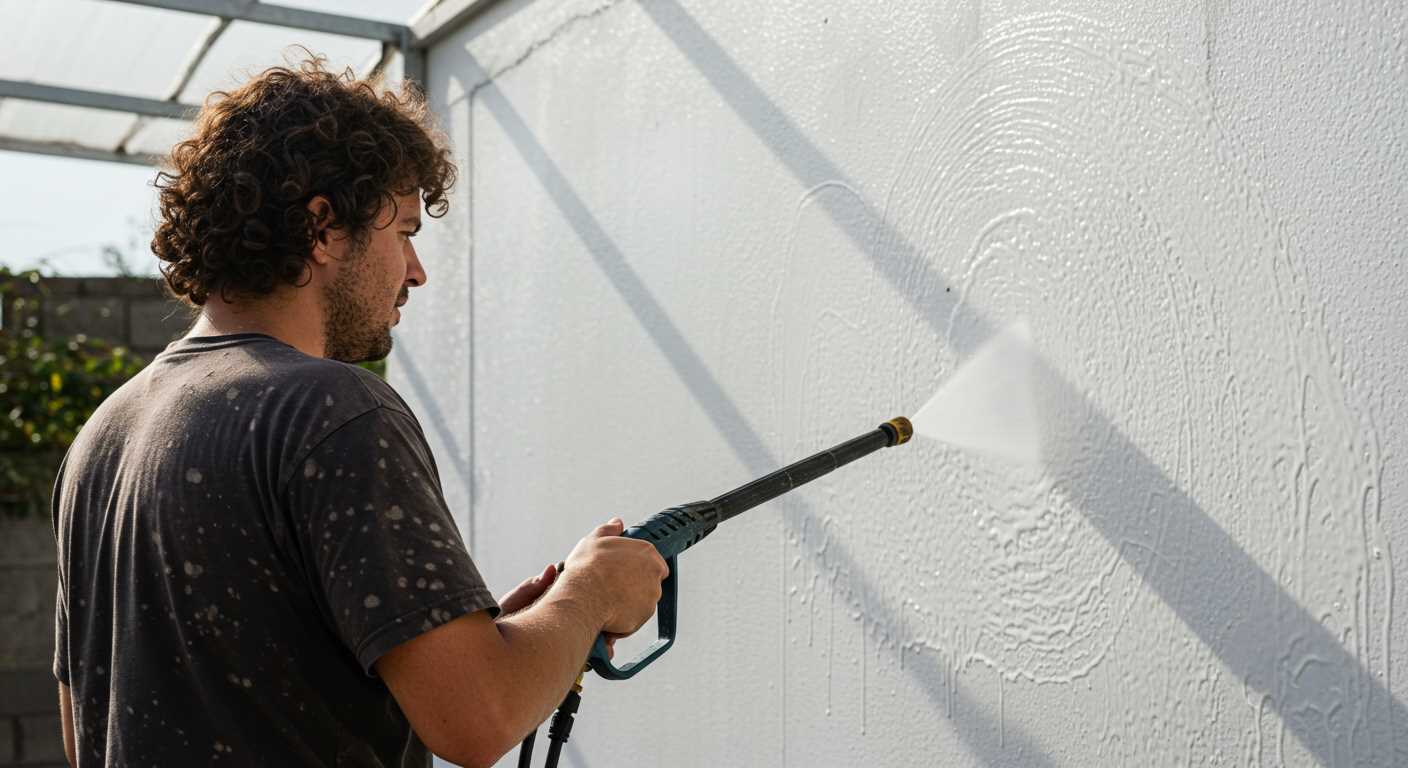



The output rate for water in standard household cleaning devices typically ranges from 6 to 8 litres per minute. This figure can vary widely depending on the specific model and manufacturer. When considering unit selection, understand that higher output can enhance cleaning efficiency, especially in tough grime or larger areas.
During my extensive experience in the cleaning equipment industry, I observed that units with a pressure rating between 100 and 120 bar often deliver optimal performance in residential settings. For residential applications, such as terrace or driveway cleaning, aiming for equipment with adjustable flow rates proves beneficial, enabling optimal results tailored to specific tasks.
In addition, it’s advisable to examine the nozzle configurations available. A narrower nozzle can increase pressure and reduce the volume of water, providing a more concentrated cleaning action for stubborn stains. Conversely, a broader angle can cover larger spaces more efficiently but may sacrifice some pressure. Selecting the right combination based on your project requirements ensures better outcomes.
Focus on long-term maintenance as well. Regularly clearing any blockages and ensuring filter cleanliness will contribute to maintaining the desired output rate, preventing degradation in performance over time. Thus, understanding these details ensures you make an informed choice that maximises the functionality of your cleaning equipment.
Flow Rate Insights from My Experience
For optimal outcomes, I recommend looking for models that deliver between 6 to 8 litres per minute. This flow rate is typically sufficient for home tasks such as cleaning driveways, patios, and vehicles. Higher-end machines may exceed this, reaching up to 10 litres per minute, which is ideal for larger jobs or especially stubborn dirt.
Understanding Pressure Specifications
The pressure output, measured in bars or PSI, is as crucial as flow rate. Machines offering 120 to 150 bar will perform well for residential use. Pairing a suitable pressure level with the right flow will enhance cleaning efficiency without damaging surfaces.
Practical Applications
When tackling various cleaning projects, consider your equipment’s specifications. For instance, while a higher flow can clean efficiently, it may also consume more water and lead to increased operational costs. Balancing power and efficiency is key to achieving the best results for home maintenance.
Understanding Pressure Washer Flow Rates
For optimal performance, it’s crucial to select a machine with suitable flow metrics. Flow rate determines the volume of liquid expelled per minute and is typically measured in litres per minute (L/min). A standard household unit delivers around 5 to 10 L/min, though some high-performance models can achieve up to 15 L/min.
Key factors influencing flow include:
- Nozzle Size: Different nozzle types dictate the spray pattern and pressure, affecting how efficiently the liquid is utilised.
- Motor Power: Higher wattage engines usually result in increased flow rates, enabling thorough cleaning.
- Water Source: Tap flow capacity can limit effectiveness; ensure the supply meets or exceeds the machine’s intake specifications.
- Hose Length: Longer hoses may reduce flow due to friction; maintain shorter connections when possible.
Regular maintenance also influences performance. Clean filters and check hoses for leaks to prevent drops in efficacy. Testing the flow rate with a bucket is straightforward: measure how much fluid collects in one minute to ensure the equipment operates at peak potential.
Ultimately, understanding flow rates empowers you to make informed choices, maximise efficiency during cleaning tasks, and prolong the life of your machinery.
Key Factors Affecting Output Speed
The flow rate from a cleaning unit depends significantly on several variables. Here are the main considerations to keep in mind:
1. Machine Specifications
- Each unit is designed with specific performance metrics, including gallons per minute (GPM). A higher GPM typically indicates greater output capability.
- Pressure ratings, measured in PSI (pounds per square inch), can influence how effectively the liquid is expelled but are not the sole determinant of flow rate.
- It’s essential to check the manufacturer’s specifications to determine exactly what to expect from a specific model.
2. Hose Length and Diameter

- A longer hose may create additional resistance, thus affecting the discharge rate. Shorter, thicker hoses often promote better flow.
- Using compatible fittings and nozzles can also prevent unnecessary bottlenecks, allowing for optimal output.
3. Water Source Pressure
- The source pressure from your tap can have a direct impact on performance. A consistent and sufficient supply helps maintain expected flow rates.
- If the inlet pressure is low, it limits the amount of liquid that can be forced through the machine.
4. Filter and Maintenance
- Clogged filters can significantly restrict flow. Regular cleaning and maintenance of filters keep systems functioning as intended.
- Inspect for any blockages or wear in hoses, connections, and nozzles to ensure unhindered output.
Understanding these elements can help make informed choices. Selecting the right equipment based on these factors can lead to enhanced performance and satisfaction in cleaning tasks.
Comparing Gallons Per Minute (GPM) Ratings
For optimal performance, evaluate the GPM ratings when selecting a cleaning unit. Machines typically range from 1.2 to 4.0 GPM, directly affecting the speed of cleaning tasks. Units rated at 1.2 to 1.5 GPM are often suitable for light tasks, such as washing cars and patios, whereas those with 2.0 to 3.0 GPM handle moderate projects like decks and driveways efficiently.
Higher ratings, around 3.5 to 4.0 GPM, are generally reserved for heavy-duty applications, ideal for commercial settings or extensive home cleaning. It’s crucial to match the GPM with the intended usage to avoid burnout or inefficiency. A unit with lower GPM might take longer but can still deliver excellent results if the pressure is adequate.
Additionally, consider the nozzle sizes and pressure settings, as these factors also influence the output. Larger nozzles increase flow but decrease pressure, which may not be suitable for detailed cleaning. Striking a balance between GPM and PSI ensures both speed and effectiveness in completing tasks.
Benchmarking different models allows for informed decisions. Look for reviews or field tests reflecting real-world performance results. Machines may deliver various results based on the conditions, so real user feedback is invaluable.
Impact of Nozzle Size on Water Flow
The size of the nozzle significantly influences the rate at which liquid is expelled. A larger diameter results in a higher volume of liquid moving through, while a smaller nozzle constricts the flow, decreasing the output rate. Therefore, for tasks requiring high water delivery, such as rinsing large surfaces, a wide nozzle is preferable.
Choose the Right Nozzle for the Job
Selecting an appropriate nozzle is critical for maximising efficiency. For instance, using a 15-degree nozzle can enhance cleaning power by concentrating the stream, ideal for tough stains, whereas a 40-degree nozzle will disperse the liquid over a broader area, suitable for delicate washing tasks. Thus, understanding the application allows for the strategic choice of nozzle size, optimising performance.
Combining PSI and Nozzle Size
The interplay between pressure and nozzle size affects overall efficiency. A high-pressure setting combined with a wide nozzle may lead to less effective cleaning due to lower surface impact. Conversely, pairing an appropriate nozzle size with suitable pressure optimises cleaning results. As an experienced consultant, I’ve often found that experimentation yields the best outcomes for specific cleaning challenges. Adapt your equipment to the task for optimal performance.
Calculating Water Velocity from Pressure Settings

To determine the exit speed of fluid from a cleaning unit, consider both pressure and flow rate. The formula for velocity (V) is derived from the fundamental relationship between pressure (P), density (ρ), and gravity (g): V = √(2P/ρ). This allows for calculating how quickly the liquid will be projected through a nozzle. Using standard household water pressure, typically around 60 psi (413.7 kPa), and assuming the density of water is approximately 1000 kg/m³, the velocity can be computed as follows:
Example Calculation: Using the formula: V = √(2 * (60 psi * 6895 Pa/psi) / (1000 kg/m³)) yields an approximate velocity of 10.3 meters per second.
Choosing Appropriate Nozzle Sizes
The velocity can also be influenced by the nozzle’s configuration. Smaller orifices increase speed but decrease flow rate, while larger ones might lower speed but enhance the volume. It’s crucial to align nozzle selection with the task. For tasks requiring high-impact force, a narrower nozzle might be optimal, whereas wider nozzles could be preferable for rinsing large areas quickly.
Flow Rate Relevance
Flow rate, measured in litres per minute (LPM), provides insight on how much fluid is delivered during operation. Higher LPM rates generally translate to greater effectiveness in covering surfaces but can also lead to lower exit speed since pressure might be reduced. Balancing these two factors ensures maximum performance for various cleaning needs.
Common Models and Their Water Flow Characteristics
After extensive testing of various brands and units, the water output of electric and gas-operated cleaners varies significantly. For instance, electric models typically range from 1.3 to 2.5 gallons per minute (GPM), whereas gas-powered units often produce between 2.5 to 4.0 GPM. This is crucial for selecting the right device depending on the cleaning task at hand.
Notable Examples
The Sun Joe SPX3000 is a popular electric machine, delivering 1.76 GPM. Ideal for light to medium-duty jobs, this model excels at removing dirt and grime without excessive water use. On the other hand, the Simpson MSH3125-S is a gas model that offers 3.1 GPM, making it highly effective for more challenging jobs, such as cleaning heavy machinery or larger driveways.
Understanding Brand Variations
Brands like Kärcher and Generac also present unique offer variations. Kärcher K5 Premium produces approximately 2.29 GPM, targeting residential users requiring a balance between power and efficiency. Generac’s 6923 model, with a robust 3.3 GPM, targets serious users needing to tackle the toughest cleaning tasks with minimal effort.
Choosing the right cleaner based on these output specifications is essential to achieving the best results for your specific needs. Evaluate the task intensity and select a model that offers an optimal GPM to maximise efficiency and effectiveness.
Optimal Usage Scenarios for Various Flow Rates
For models delivering 1.2 to 1.5 GPM, optimal tasks include light cleaning, such as washing cars or patio furniture. This range ensures sufficient force without risking damage to delicate surfaces. I recommend using a fan nozzle for broader coverage, minimising water usage while maintaining effectiveness.
When the flow rate increases to 1.5 to 2.0 GPM, more challenging projects become feasible. These machines excel at cleaning decks, fences, and siding. A turbo nozzle can enhance cleaning efficiency, harnessing greater pressure to remove stubborn dirt and grime. Keeping a reasonable distance from surfaces reduces potential harm.
For units producing 2.0 to 3.0 GPM, tackling heavy-duty tasks is straightforward. These devices are well-suited for cleaning driveways, concrete paths, and larger outdoor areas. A surface cleaner attachment can maximise coverage and minimise cleaning time, especially on expansive surfaces.
Beyond 3.0 GPM, the focus shifts to industrial applications. These machines are designed for professional environments, suited to constant use in commercial settings. Regular maintenance and understanding the machine’s mechanics are critical to ensure longevity and performance in such intensive scenarios.
Choosing the right flow rate not only affects cleaning efficiency but also influences water consumption. Balancing pressure with the correct nozzle selection maximises results while conserving resources. For any project, assessment of the specific requirements will lead to the best outcomes.
Maintenance Tips to Ensure Consistent Water Flow

Regularly inspect and clean the inlet filter. A clogged filter can restrict fluid intake, resulting in inconsistent output. Remove it every month and rinse under clean water to eliminate debris.
Check all hoses for kinks or damage. A compromised hose can diminish performance significantly. Replace any hose that shows signs of wear to maintain optimal flow.
Fluid Supply Check
Ensure your supply tap is fully open and that you have adequate pressure in your plumbing system. A weak source can drastically affect performance. If possible, test your system with a pressure gauge to confirm adequate supply pressure.
Regular Maintenance Schedule

Create a maintenance schedule that includes seasonal checks on components. Make a point to flush the system periodically to remove any sediment buildup that may impair flow.
| Maintenance Task | Frequency | Description |
|---|---|---|
| Inspect inlet filter | Monthly | Remove and rinse to clear debris |
| Check hoses | Monthly | Look for kinks or signs of wear |
| Flush system | Quarterly | Remove sediment that may affect flow |
| Test supply pressure | Bi-annually | Ensure your plumbing system provides adequate pressure |








